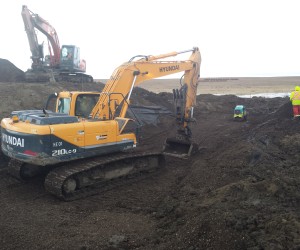The liquid limit of a soil is the moisture content at which:
- a soil changes to a liquid state.
- the boundary between the plastic and liquid states occurs.
- a soil loses its shear strength.
Clearly a soil will not lose its shear strength all at once as water is being added, but there is a range within which it loses most of it. In industry practice, the standard ASTM test is used to define the liquid limit so everyone is talking about the same thing.
The test procedure is ASTM D4318. It involves placing some of the soil in a bowl and cutting a straight groove through it with a standardized 13.5 mm wide tool. The bowl is dropped repeatedly at 120 blows per minute until the groove closes. The test is run at multiple moisture contents, and the one which makes the groove close at 25 blows is the liquid limit.
The liquid limit is used in the classification of soils in the USCS classification system. It establishes the second letter in the classification as either L or H. For example, clay is either CL or CH depending on the liquid limit.
It is one of the Atterberg limits. The others are plastic limit and shrinkage limit.

Speak Your Mind